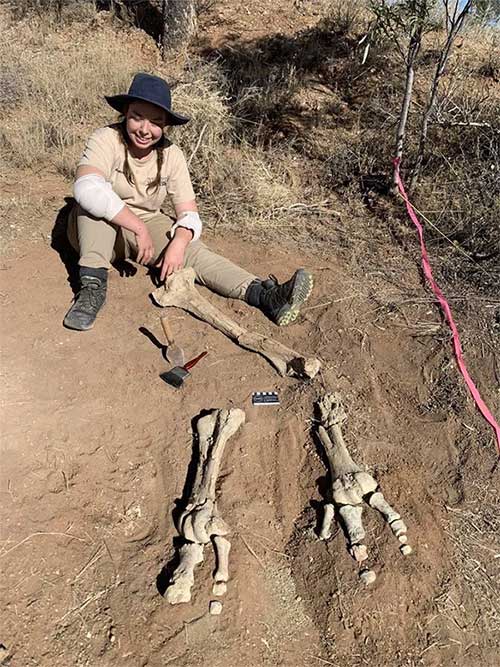An intact 8-million-year-old skeleton of an extraordinary bird has been discovered in Central Australia, described by paleontologists as an extreme evolutionary experiment.
This is the largest bird species ever recorded, as large as a giant dinosaur: standing 3 meters tall and weighing at least half a ton, it features a collection of bizarre anatomical traits.
According to Science Alert, this “divine bird” has been given a legendary name, “Thunderbird of Striton,” or Dromornis stirtoni in scientific nomenclature.

A scientist next to the foot and leg bones of the newly excavated “divine bird” – (Photo: TWITTER)
It possesses an oversized beak protruding from a relatively small skull, mounted on a gigantic body. The determination of its “lineage” has been described by researchers as “just to make the animal sound more ridiculous”, indicating a close relation to modern chickens and ducks, but it is a true “devil duck.”
Dr. Adam Yates, a paleontologist in charge of Earth Sciences at the Northern Territory Museum and Art Gallery in Australia, described to Science Alert that the exposed skeletal parts are accurately arranged according to the anatomy of the creature. “That means the corpse is intact as it was when it was buried” – Dr. Yates said.
Currently, scientists have only excavated the lower limbs of the creature and are digging deeper to search for remaining parts, hoping it is a complete skeleton.
This is always a slow and meticulous process as not only are fossilized remains very fragile, but paleontologists need to fit the bone parts together correctly. Just a slight misalignment can lead to significant errors and make the reconstruction of the “portrait” of extinct species even more challenging.
According to paleontologist Warren Handley and colleagues from Flinders University in Australia, they previously found another individual nearby, but it consisted only of some small and disorganized bone fragments, possibly from a male of the same species, which did not help in describing this peculiar creature. The one just discovered is a female.
However, the presence of two individuals has already helped them identify some basic differences between male and female birds.
Eight million years ago, these “divine birds” may have roamed dry forests, using their large beaks to eat fruits and other animals.
The “divine bird” site was discovered at a fossil treasure trove named Alcoota, located in a remote area where the remains of several species of ancient kangaroos and marsupial lions have been found.





















































